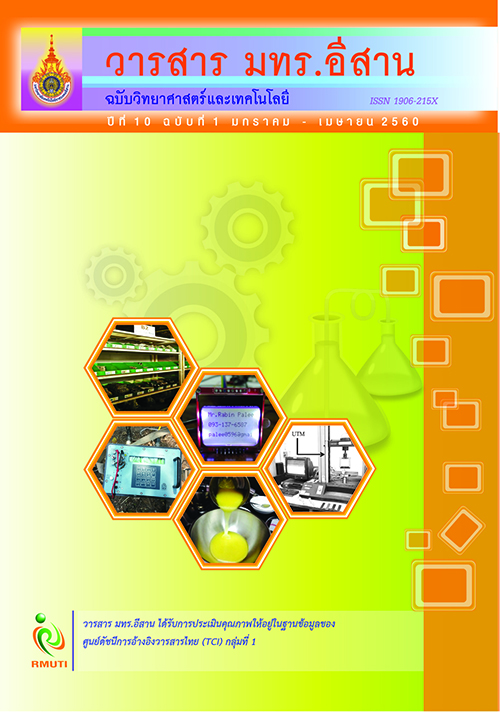การประเมินการรับสัมผัสทองแดงในฝุ่นที่มีผลต่อสุขภาพผู้ปฏิบัติงานผลิตช้อน กรณีศึกษา กลุ่มภูมิปัญญาท้องถิ่น (The Exposure Assessment of Copper in Dust for Spoon Worker; A Case Study in Local Wisdom Group)
Main Article Content
Abstract
บทคัดย่อ
การศึกษาวิจัยครั้งนี้มีวัตถุประสงคเ์ พื่อประเมินการรับสัมผัสทองแดงในฝุน่ ที่มีผลตอ่ สุขภาพของผูป้ ฏิบัติงาน
ผลิตช้อน กรณีศึกษากลุ่มภูมิปัญญาท้องถิ่น ศูนย์หัตถกรรมทองลงหิน กลุ่มตัวอย่างคือ ผู้ปฏิบัติงาน
จำนวน 30 คน ซึ่งทำงานในแผนกเจียรและแผนกขัดเงา เครื่องมือในการวิจัย คือ แบบสอบถามและ
เก็บตัวอย่างในอากาศแบบพื้นที่ การวิเคราะห์ปริมาณทองแดงใช้เทคนิค Atomic Absorption
Spectroscopy ผลการศึกษาพบว่า ปริมาณทองแดงในแผนกขัดเงาที่ 8 มีปริมาณค่าความเข้มข้นของ
ทองแดงในฝุ่นในบรรยากาศการทำงานมากที่สุด เท่ากับ 0.5996 รองลงมาคือ แผนกเจียรที่ 3
เทา่ กับ 0.4687 ซึ่งผลการวิเคราะหด์ ังกลา่ วไมพ่ บคา่ ที่เกินมาตรฐานเมื่อเปรียบเทียบกับคา่ มาตรฐาน
ของ NIOSH ที่กำหนดค่าความเข้มข้นไว้ที่ 1 อย่างไรก็ตามผู้วิจัยได้ประเมินค่าความเสี่ยง
อันตรายต่อสุขภาพ (Hazard Quotient; ) พบว่า แผนกขัดเงาที่ 8 มีค่า มากที่สุด (เท่ากับ
2.9375) รองลงมาคือ แผนกเจียรที่ 3 (เท่ากับ 2.2900) หากค่า ที่มากกว่า 1 แสดงให้เห็นว่าปริมาณ
ทองแดงโดยเฉลี่ยที่ร่างกายได้รับอยู่ในระดับที่ไม่ปลอดภัยต่อสุขภาพของพนักงานและควรดำเนินการ
แก้ไขความเสี่ยงนี้
Abstract
The purpose of this research was to investigate the exposure assessment of copper in
dust for spoon workers. The samples were 30 representatives of spoon workers in
grinding and polishing work. The study tool was a questionnaire and area sample.
The determination of copper in dust used atomic absorption spectroscopy technique.
The study found that the concentration of copper in grinding work (no. 8) is 0.5996 .
The secondary concentration of copper was grinding work (no. 3), an average of
0.4687 . The analysis does not exceed the standard of NIOSH at 1 (dust).
However, the researchers assessed the risk of hazard quotient of spoon workers.
The result revealed that, the hazard quotient of spoon workers in polishing work
(no. 8) is higher (an average 2.9375). The secondary of hazard quotient was grinding
work (no. 3) (an average 2.2900). If the hazard quotient is greater than 1 it shows
that the average amount of copper in the body can be unsafe for health and risk
management.
Article Details
References
of Folk Wisdom on Bronze ware in Ban Bu Community, Bangkok. [Thesis]. Bangkok:
Graduate School, Srinakharinwirot University. (in Thai)
[2] U.S. Environmental Protection Agency. (1989). Risk Assessment Guidance for
Superfund Volume I Human Health Evaluation Manual (Part A). Office of Emergency
and Remedial Response. Washington, D.C.
[3] Anamai Thetkathuek. (1999). Health Risk Assessment. Faculty of Tropical Medicine.
Mahidol University. (in Thai)
[4] Pornchai Wangjaisuk. (2005). A Study on Factors Affecting Working Behavior of
Workers in Aluminium Manufacturing Plant. [Thesis]. Bangkok: Graduate School,
Kasetsart University. (in Thai)
[5] Poonsub Suanmeung Tulapan. (2014). Health Problems Safety and Environmental
Performance of the Production at Home in Thailand. Access (10 January 2014).
Available (http://www.homenetthailand.org/index.php/th/article-th-th-2/149-
article2-th-th-2)
[6] Xin Hua, Yun Zhangb, Zhuhong Dingb, Tijian Wangc, Hongzhen Liana, Yuanyuan Sund
and Jichun Wud. (2012). Bioaccessibility and Health Risk of Arsenic and Heavy
Metals (Cd, Co, Cr, Cu, Ni, Pb, Zn and Mn) in TSP and PM2.5 in Nanjing, China.
Atmospheric Environment. Vol. 57. pp. 146-152
[7] Bureau of Environmental Health Department of Health. (2016). Air Quality Control.
Access (22 January 2016). Available (https://web.ku.ac.th/schoolnet/snet6/envi4/c_air/
c_air.htm)
[8] Winifred Ka Yan Lau, Peng Liang, Yu Bon Man, Shan Shan Chung and
Ming Hung Wong. (2014). Human Health Risk Assessment Based on Trace Metals
in Suspended Air Particulates, Surface Dust, and Floor Dust from E-Waste Recycling
Workshops in Hong Kong, China. Environmental Science and Pollution Research.
Vol. 21. No. 5. pp. 3813-3825
[9] Srirattana Vanichadisak and Chawalit Kittichaikarn. (2009). Design of Ventilation
Systems in Chemical Factories a Case Study : Ventilation Systems in PL-Z Rooms.
Kasetsart Engineering Journal. Vol. 69. No. 22. pp. 70-79. (in Thai)


